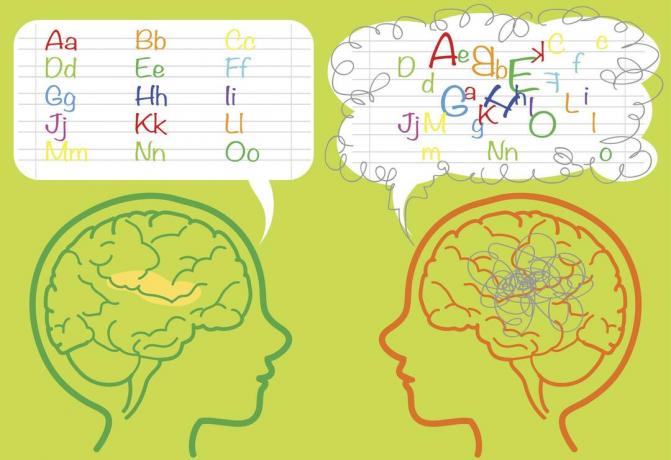
Dyslexia is a language disorder of neurobiological origin, which mainly affects literacy, that is, the ability to read and write. These skills are separate but united processes at the same time, since when we write we are forced to constantly engage in reading activities.
In addition, dyslexia is one of the learning disorders that occurs more frequently in the population. children, with a prevalence of between 5% and 10%, although according to some studies it may reach 17.5%. So dyslexia, without a doubt, represents a very important problem, due to its consequences in the academic field and its emotional repercussions.
If you are interested in learning more about dyslexia, do not hesitate to continue reading this Psychology-Online article: what is dyslexia: symptoms, types, causes and treatment.
Commonly, dyslexia begins to be detected when the child begins to enter the process of learning to read and write, that is, from 2-3 years to approximately 7 years. Early detection of dyslexia symptoms is vitally important.
The main symptoms of dyslexia are the following:
- The main symptom that generally and broadly characterizes dyslexia is a great difficulty during learning and reading acquisition, which is an unexpected difficulty in relation to other abilities shown by the person and her educational circumstances.
- The second most common symptom among people with dyslexia is poor school performance in all subjects that require reading as a learning base, since having difficulties in reading and writing implies greater difficulty in the learning process of certain subjects or concepts. For example, they can be given problems in the rhythm and speed of learning written language, difficulties for copying from the blackboard to the notebook, among others. In addition, it must be taken into account that reading and writing are essential in most of the subjects, either by reading books or by reading the questions and writing the answers on a exam.
- Phonological deficit: the vast majority of people who suffer from dyslexia, suffer at the same time a phonological deficit, that is, a deficit in some aspect of the representation and processing of the sounds of language. This may be due to a weak ability to consciously attend and manipulate the sounds of the tongue, to a short-term verbal memory that limits the ability to maintain momentarily activates the phonological representations, and / or a slow ability to recover the phonological forms of the words with the aim of undertaking the articulation of the speaks.
- Auditory processing problems, especially fast sound processing.
- Visual acuity problems.
- Motor problems.
- Difficulty paying attention.
- The person shows slowness or an abnormality in the development of verbal language.
- Difficulties in reading, writing, spelling, vision, motor coordination, mathematics, understanding of time, situation in space and limitation of the ability to integrate information that they understand separately. That is, they confuse letters, change syllables, delete or add letters or words, have difficulty memorizing spelling rules, and have difficulty with fine and gross motor skills.
These are the characteristics that you can look at if you suspect your child has dyslexia. You can also do these 10 exercises to detect dyslexia.
Currently, and despite the large amount of research carried out on dyslexia, the causes of its origin are not exactly known. Thus, the following could be mentioned as possible causes of dyslexia:
- Hereditary factors: If there is a history of family members who suffer from dyslexia, the person will be more likely to suffer from dyslexia.
- Genetics: Another cause of dyslexia is genetic factors.
- Brain injuries.
- Emotional problems.
- Sequence orientation problems: Another cause of dyslexia is sequence orientation problems. Sequence orientation allows people to order objects, events (past, present, future), among others. People with dyslexia show difficulty in ordering the events of a book, for example, temporally.
- Visual perception problems/ Perceptual-visual disorder.
- Lack of brain dominance: the brain is divided into two hemispheres (the right and the left), so that the right part of the brain has the role to control the left part of the body and, conversely, the left part of the brain controls the right part of the Body. Thus, people who have a dominance in the left part of the brain have an easier time controlling the right part of their body and have more difficulty controlling the left (for example, in this case they would write with their right hand, kick a ball with their leg right…). Therefore, the lack of brain dominance refers to the two parts of the brain, giving rise difficulties in mastering the body effectively, including the hands and fingers when to write.
- Another cause of dyslexia is poor connection between the two brain hemispheres.
- Low phonological awareness.
Regarding the treatment of dyslexia, some considerations are necessary. First of all, it is important treating dyslexia early, since both reading and writing are essential processes in human development. On the one hand, reading provides cognitive autonomy, creates habits of reflection, effort, concentration, among others. On the other hand, writing serves to relate to the environment, as a form of expression, as a study tool, and much more.
Dyslexia is not a curable disorder, but it can be treated, using different therapeutic approaches depending on the age of the person. Fundamentally, dyslexia treatment measures are based on interventions on language, phonology and reading, adapting each and every one of the measures to the individual, in order to personalize the treatment to the individual needs and characteristics of each person. Also adapting the treatment to age, since the application of treatment techniques to children who treating dyslexia in teens.
It is common for people with dyslexia to have other associated problems, which should also be treated, such as attention difficulties, motor difficulties, among others.
A common practice that is carried out in the treatment of dyslexia is the so-called “overlearning”, which consists of relearning the process of literacy, but, in this case, adapting the pace to the area of proximal development of the person. That is, it consists of adapt the teaching-learning process of literacy adapted to the rhythm and individual characteristics of the person. In addition, in the treatment of dyslexia, special emphasis is placed on working with the guiding principle of error-free learning, promoting successes throughout the process, since people with dyslexia tend to have a low tolerance to frustration.
In short, from the treatment of dyslexia it is sought correct the factors or impaired functions that cause the symptoms of dyslexia and, therefore, promote an improvement in school learning, academic achievement and success in life.
This article is merely informative, in Psychology-Online we do not have the power to make a diagnosis or recommend a treatment. We invite you to go to a psychologist to treat your particular case.
If you want to read more articles similar to What is dyslexia: symptoms, types, causes and treatment, we recommend that you enter our category of Learning disorders.


1 from 2
What is dyslexia: symptoms, types, causes and treatment


